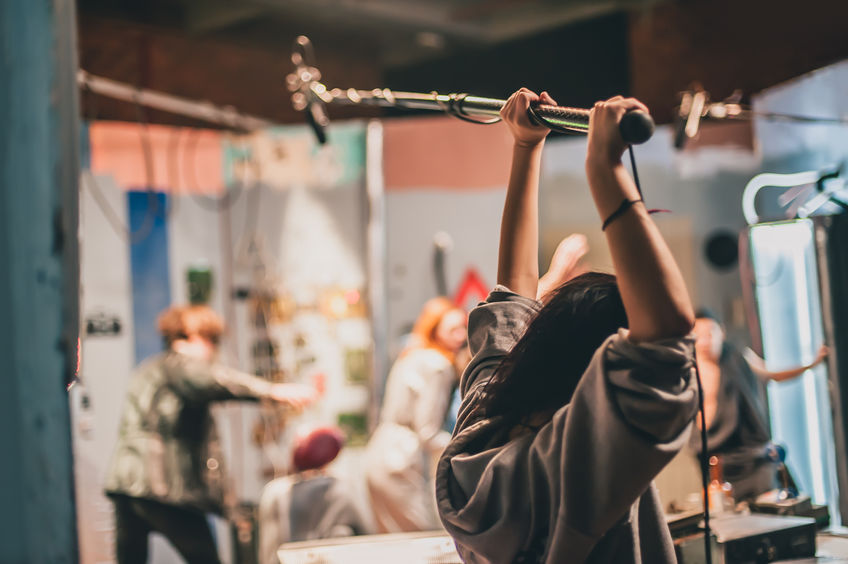DISCLOSURE: AS AN AMAZON ASSOCIATE I EARN FROM QUALIFYING PURCHASES. READ THE FULL DISCLOSURE FOR MORE INFO. ALL AFFILIATE LINKS ARE MARKED #ad
Good audio is one of the most important aspects of making a video project feel professional. To get good audio, it’s important to have your mic as close to the source as possible while staying out of the shot.
This is where boom poles come in. And, if you’ve ever been the one holding it, then you know that all booms are not created equal.
In this article, we will look at a range of five different boom poles on the market for different budgets and examine the pros and cons of each product.
Table of Contents
1. On-Stage MBP7000 Handheld Microphone Boom Pole
- Weight: 0.43kg / 0.95 lbs
- Length Adj.: 94 – 246 cm / 3.1 – 8.1 ft
- Compatibility: 5/8” thread
Strengths: For those on a budget, this super lightweight aluminum boom pole is a good bang for your buck. Only weighing one pound, you can be sure it won’t ever be too heavy.
Weaknesses: Durability is a consideration for boom poles on the lower end of the price spectrum. The plastic locking mechanisms must be treated carefully to ensure the product’s longevity. Also, weight is a consideration if you are using a heavier microphone.
Description: The On-Stage MBP 7000 is a cheap boom pole you can count on to complete the job. The plastic locks need to be treated with care, but for someone on a budget, this could be the boom for you.
2. LyxPro MPL-20 Portable Mic Boom Pole Arm
- Weight: 0.95 kg / 2.1 lbs
- Length Adj.: 72 – 281 cm / 2.37 – 9.25 ft
- Compatibility: 3/8″ thread, 5/8″ adapter
Strengths: This dependable and sturdy boom pole has little to no bowing. This boom pole also comes equipped with an internal coiled XLR cable, allowing quick connection directly to a microphone.
Weaknesses: The internal cable can make noise if the boom needs to be moved around quickly. This is also the heaviest of the suggested boom poles, and so while still weighing only 2.1 lbs, this pole is on the heavier end.
Description: The LyxPro MPL-20 is a durable boom pole that will last if treated with care. Being equipped with an internal cable makes this boom handy if you need to mic on the fly. Some caution is needed to ensure the boom won’t make any noise when moving during a take.
3. Koolertron Carbon Fiber Lightweight Boom Pole
- Weight: 0.8 kg / 1.76 lbs
- Length Adj.: 90 – 290 cm / 2.95 – 9.51 ft
- Compatibility: 3/8″ thread
Strengths: This carbon fiber boom pole remains lightweight while reaching almost 7 feet in length. Sturdy and durable, this boom will last you a long time.
Weaknesses: You may need a ⅝” adapter with this boom unless you already have a ⅜” setup. Be sure to check your gear and any mounts you may use. This pole also cannot run an XLR cable through the inside.
Description: This Koolertron Carbon Fiber Boom Pole is lightweight, sturdy, and dependable. If your gear has ⅝” threads, you’ll need an adapter for this product.
4. K-Tek KE79CCR Avalon Series Aluminum Traveler Boom Pole
- Weight: 0.72 kg / 1.6 lbs
- Length Adj.: 54 – 204 cm / 1.66 – 6.58 ft
- Compatibility: 3/8″ thread, 3-pin XLR cable port
Strengths: This aluminum boom pole also has an internal coiled XLR cable. It telescopes just over a foot and a half in length and is extremely portable. This is a reliable and durable boom.
Weaknesses: This boom costs more than the other recommended products. You also might need a ⅝” adapter if you aren’t set up to mount your mic on a ⅜” thread.
Description: This K-Tek KE79CCR Avalon Series boom is lightweight and dependable. It is extremely portable, collapsing to just over a foot and a half. It also is equipped with a coiled internal XLR cable.
5. Rode Boompole Pro Carbon Fiber Microphone Boom Arm
- Weight: 0.53kg / 1.3 lbs
- Length Adj.: 81 – 300 cm / 2.66 – 10 ft
- Compatibility: 3/8″ thread
Strengths: This carbon fiber boom pole is strong and lightweight. It can also reach very far, with a length of 10 feet. There is minimal noise transfer when moving the boom. The Rode Boompole Pro is a good product for the price.
Weaknesses: Once again, the plastic locking mechanism is a point of weakness. Be careful when tightening and loosening the joints to make this boom pole will last for a long time.
Description: The Rode Pro Carbon Fiber Boom Arm is a quality, lightweight, and versatile product with a long reach of 10 ft. The boom isn’t equipped with an internal XLR cable, and care should be taken to tighten the joints to ensure longevity.
A Buyer’s Guide to Boom Poles

There are many different boom poles, so knowing what to look for can be hard.
Ideally, you will find something lightweight, durable, with a good reach, and that will limit any handling noise. We’ve chosen five of the best options on the market just for you.
It should also be stated that you will need a microphone or shock mount to attach your mic to a boom pole. These often mount to ⅝” or ⅜” threads. Be sure to check how your microphone will mount, and understand that you may need an adapter.
Important features to consider when buying a boom pole

Since your boom is meant to help you get the cleanest sound possible, there are important features to consider.
An adjustable length is convenient for maneuvering the microphone into the desired location.
Also, having a sturdy boom arm with little flex is a must. That’s why some of the best are made from carbon fiber.
Another thing to consider is having the option to have your XLR cable run on the inside of the boom pole, which makes it easier to handle and minimizes cable chaos.
In short, lightweight and telescoping boom poles are versatile and valuable tools for filmmakers in almost any situation.
When To Use Boom Poles?

Boom poles can be used when recording audio, and a camera-based microphone won’t cut it. As the distance between the subject and the camera increases, the microphone picks up more noise and less of the intended sound.
Whether indoors or outdoors, in the newsroom or theatre, making music videos, or filming a documentary, a handheld boom can help you maximize the audio quality in a versatile and adaptable way.
Stationary boom arms are on the market for static settings in the studio (see 5 Best Boom Arms).
Boom poles maneuver the microphone as close to the audio source as possible while remaining out of the shot.
Experienced boom masters often make micro-adjustments to optimize the sound quality of each subject in a scene.
How to use a boom pole. Get close to the action and keep still!
To get the best quality sound, the closer the microphone is to the source of your audio, the better.
In many cases, even a great camera-based microphone isn’t sufficient to get the audio you need at any distance away from your subjects.
At its very essence, a boom pole is a simple tool; when held at one end and with a microphone at the other, it allows you to maneuver your mic as close to the action as possible while remaining out of the camera frame.
The boom is usually positioned above the action, with the microphone overhead and facing the ground.
A lot less noise comes from the ground than in any other direction, so by pointing the microphone down, it picks up much less unwanted noise from the surroundings.
This allows you to eliminate as much noise as possible while maximizing your desired audio.
It’s important to have a good boom pole, as the boom operator can hold the mic for long periods.
Another consideration is how much noise the boom might produce. The microphone can pick up tapping or rattling coming on a boom.
Closing Thoughts
So there you have it. I hope you’ve learned some valuable tricks for improving the audio of your videos. Boom poles are an essential tool for getting your microphone where it needs to be; many products are out there to help you do that.
There are always pros and cons to any product. Whether you prefer an internal cable or wrapping you need a good boom pole that you can depend on to do the job.
Remember to treat your boom carefully to get the most use out of it. Keep at it, and I hope you’re inspired to get out there and keep filming!

